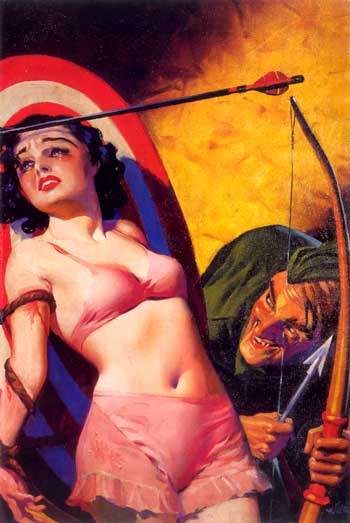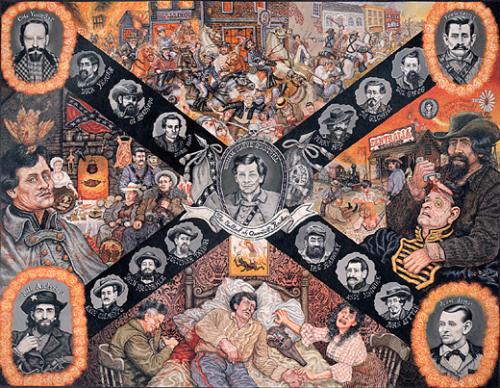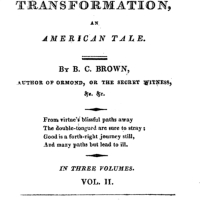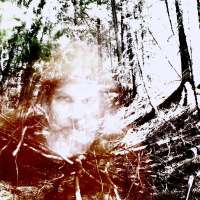American Gothic #3: American Gothic Art

(Click on the images to enlarge them.)
Now we come to American Gothic Art. And I think we can say with some confidence if anything has a mangy pedigree in the art world this breed certainly does. American Gothic Art was not born in the studios and galleries of New York City. It is not sold in crafts fairs. It rarely touches the confines of well-considered art in any degree. Only Edward Hopper’s dark desolate structures speak of the kind of quality that is spoken of with admiration in the tonier climes of the art world. But most of the rest of it? Junk really: Cartoons and sideshow banners, pulp and comic books. It’s just illustration: a word sniffed at in some quarters; and with good reason.
Before we get too far into the subterranean realms of art’s American gothicisms, let’s point out what American Gothic Art isn’t. First and foremost, Grant Wood’s American Gothic certainly is in no way American Gothic. (See American Gothic #1.) Jasper John’s American flags are not Gothic. Georgia O’Keefe’s cow skulls are too spiritual, too proto-New Agey, to be called Gothic. Likewise no Pop Art, Minimalism, Abstract Expressionism, no Modernism in general, are connected with it in any way. And all Postmodernism by definition is excluded from American Gothic. But on the opposite end of spectrum: Currier and Ives and especially Norman Rockwell’s cute Americana are not American Gothic, nor do I think they ever will become so. And American illustrations of European Gothic do not qualify, even, as in Bernie Wrightson’s Frankenstein, they are created by artists with a real American Gothic touch.
Again American Gothic has to use American themes, particularly themes now truly lost to the present, or an imagining of the present in its entropic future all the while thoroughly connecting it with America’s past.
The first evidence of something uniquely American Gothic that I can locate is to be found in the works of illustrator and political cartoonist Thomas Nast. He worked for nearly all of the second half of the 19th Century. His most notable illustrations were featured in Harper’s Weekly, which bears some relationship to England’s Punch. While much of Nast’s political cartooning is beyond the scope of this essay once in a while he would portray a theme rife with a specific kind of American darkness. His depiction of Confederate President Jefferson Davis reaping a harvest of skulls is a completely realized American Gothic work of art. And it’s from 1861! And that leads one to speculate how far back American Gothic imagery actually goes. Just as clear is Nast’s influence on Edward Gorey. (And Gorey is a huge influence on filmmaker and artist Tim Burton.)
A brief mention should also be made at this point of Frank Leslie’s Illustrated Newspaper from the 1880’s. His work often had a curious haunted edge to it.
After the rather outlandish political cartoons of the late 19th Century, (Don’t even get me started on all that minstrel and coon imagery!) we next jump the caravan of the touring carnival sideshow. The truly American institution of the traveling carnival is near to the heart of American Gothic Art. The clumsily painted sideshow banners and circus and freak show posters are a real influence upon the visual palette of the American Gothic imagination.
The Western Frontier contains another cluster of Gothic images waiting to be born. Besides the many illustrations from Dime Novels, even the classic Western Artists like Frederick Remington would occasionally hit upon an image resonant with a receding view of the dark frontier. James Earle Fraser’s famous statue End of the Trail with it’s slouching native warrior reeks of desolation, sorrow and finiteness. Much of the imagery surrounding the destruction of the Native American has acquired an American Gothic flavor. And anytime you see an Indian burial ground in a work of literature (Stephen King) or film (Jeremiah Johnson) you are almost automatically in an American Gothic situation.
In the first half of the 20th Century the carnival with its tricksters and hustles continued to be both a source of fascination and a slowly dying way of life. Yet in films like Nightmare Alley and Freaks and in pulp magazines and comics it yielded much to the artistic side of the American Gothic vision.
Speaking of pulp magazines, we can’t pass by the curious art works of these little rough-hewn compendiums. While much of the art was purely fantasy or science fiction, jungles and robots and barely clad women in a degraded post-symbolist style. Periodically an artist like Virgil Finlay might portray a Gothic scene with purely American roots.
In the 1930’s the WPA (Works Progress Administration) supported many artists including several with definite American Gothic leanings. Thomas Hart Benton’s post-Van Gogh murals and paintings occasionally showed the frightening side of rural America. His Approaching Storm and Prodigal are masterpieces.
The WPA artist who calls forth most eerily with a vision of a lonely desolate America is Edward Hopper. His justly famous Nighthawks is one of the pinnacles of American art and, like most American Gothic work, is completely unaffiliated with the trends of the art world. In Hopper we enter a world of isolation and starkness that is in full concord with the American Gothic prophecy. And quite clearly Hopper’s work has much in common with the worlds of the Hardboiled Detective and Film Noir. (But we’ll leave aside those implications for now.)

Spooky Americana in Edward Hopper’s Noir Classic Nighthawks (Sometimes called Nighthawks at the Diner)
At last we come to the 1950’s and another fountainhead of the American Gothic: EC Comics, particularly their horror titles. Starting from the point where Virgil Finlay left off artists like Johnny Craig and ‘Ghastly’ Graham Engels might conjure up a deeply unsettling apparition of the dark heart of America. One cannot overstate the influence of EC Comics upon contemporary horror films. Just one example: George Romero’s decaying walking dead can be found here in a form halfway between the Haitian zombie and the living dead of contemporary culture. EC Comics were so intense that they were eventually banned. But in fact they were quite intelligent and their art might truly be seen as a high water mark of comic book history.

A Favorite American Gothic Weapon, the Ax, Makes an Appearance on the Cover of Tales From the Crypt #41
Then came the hippie generation and while the multiplicity of paeans to a kind of overblown indiscriminate love infested both the world and the word underneath the naïveté darker questioning American Gothic seeds began to sprout. One could argue that the underground comics in their scatological anarchy contained many American Gothic ideas. The works of Jaxon, Jack Jackson, come to mind readily. And R. Crumb’s work would eventually shift tone from bubbly acid playgrounds to a veritable Gothic gallery of a decaying America. Meanwhile even at DC Comics, a bastion of caped superheroes, a strange scarecrow-like figure, Brother Power, The Geek, betrayed the hallucination of a gothicized version of what the hippies themselves would eventually look like drenched in dark psychedelia.

Brother Power, The Geek – Inverting the Optimistic Hippie Dream into an American Psychedilc Nightmare
In comic book land the American Gothic urge was being revived in other ways: First through Warren’s Creepy and Eerie Magazines, then through the arts of many mainstream comic artists, of whom Bernie Wrightson stands out as one of the great American Gothic artists of anytime. In the Seventies he drew vampires, aliens, superheroes and the rest, but his Gothic Americana stands out. Strongly influenced by EC Comics his works often summon up the more unnerving aspects of the American nightmare. Mementos is more than just Norman Rockwell’s rural inversion. It delivers such a strong statement of that gulp-worthy sense of American Gothic black humor as well. In comes as no surprise that Wrightson also depicted a stunning variation on The Texas Chainsaw Massacre. (See American Gothic #1) And his interest in the dark carnival Freak Show is perfectly consistent with the deepest traditions of the American Gothic idea.
Wrightson also understands the power of the EC & Romero styled zombie as the personification of future dread. And it is his fascination not only with the macabre but the specifically decayed dream of an America at the close of its classic age that links him with the nauseating bleakness of outsider artist Joe Coleman. Coleman in his performance art bit the heads off mice, in direct emulation of the sideshow geek, stubbed out cigars on his face and blew himself up with fireworks at that most American of events, the high school reunion. Meanwhile his crammed paintings were filled with the decadent icons of a psychotic country: Charles Manson, Ed Gein, PT Barnum and Quantrill’s raid on Lawrence Kansas. Joe may be an outsider to the art world, but his work is perfectly in line with American Gothic tradition.
American Gothic Art lives like its subject matter on the fringes of an America grown almost pathologically optimistic. Its citizens thrive on conspiracy theories while living vicariously through various commercial pop culture mirages. American Gothic Art, unlike the regnant postmodern species, holds up the prophetic mirror of a ruined future rooted in an abandoned past and a deaf and blind present. As we move on into American Gothic Film we see these motifs intensified.
Come back again if you dare…
Byrne Power
Haines, Alaska
6/18/11




























